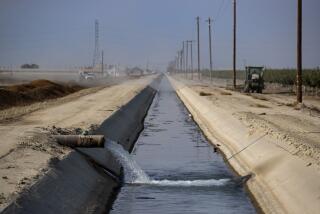Out of the Swamp of Wetland Policy : Clinton Administration wades into deep end of vital water quality issue
- Share via
President Clinton’s wetland proposals, presented last week, are significant in two respects. They are another indication of the President’s sincere desire to resolve long-running controversies left over from the Bush Administration, such as the mushrooming federal deficit and the battle over Pacific Northwest forest resources. The President’s wetland plan, moreover, will help stem, and could eventually reverse, the loss of an important natural resource. But his package should be a starting point for overdue reform, not the final word from the White House.
Wetlands are the swamps, marshes and pools that help purify water supplies. They are home to a third of the nation’s endangered species and half of its migratory birds. Wetland preservation is key to water quality improvement, ecological diversity and mitigation of the effects of such natural disasters as floods. Yet the United States is rapidly losing wetlands. Wetlands estimated at 230 million acres at the beginning of the European settlement have shrunk to about 100 million acres in the 48 contiguous states. (Alaska has an additional 170 million acres.) By the mid-1980s the nation was losing 290,000 wetland acres each year.
Much of this lost acreage has become shopping malls, housing developments and farmland. Clinton’s proposals are designed to stem that loss, as were those of George Bush. The Clinton Administration package is tougher in some respects. An executive order would set “no net loss” of wetlands as national policy and aim to actually increase wetland acreage. No development of Alaska’s wetlands would be permitted, and some loopholes that have permitted wetland draining and development would be closed.
Other proposals in the package are troubling, such as plans to delegate authority to state and local governments to run the nation’s wetlands program. Under the Clean Water Act, this responsibility currently rests with the federal government; localities often lack the funds and scientific expertise to manage these resources.
Also of concern is the proposal to allow private landowners, but not environmental activists, to appeal the federal government’s determinations that areas are or aren’t wetlands.
Clinton’s package comes just after Gov. Pete Wilson unveiled his own plan to increase the amount of California wetlands by as much as 50% while simultaneously making it easier for developers to gain permission to build in some environmentally sensitive areas. Also pending are congressional bills, including one by Sen. Barbara Boxer (D-Calif.), to bolster wetland protections. The stronger protections--and fuller detail--in some of these federal proposals are worth a close look by the White House.
More to Read
Sign up for Essential California
The most important California stories and recommendations in your inbox every morning.
You may occasionally receive promotional content from the Los Angeles Times.










